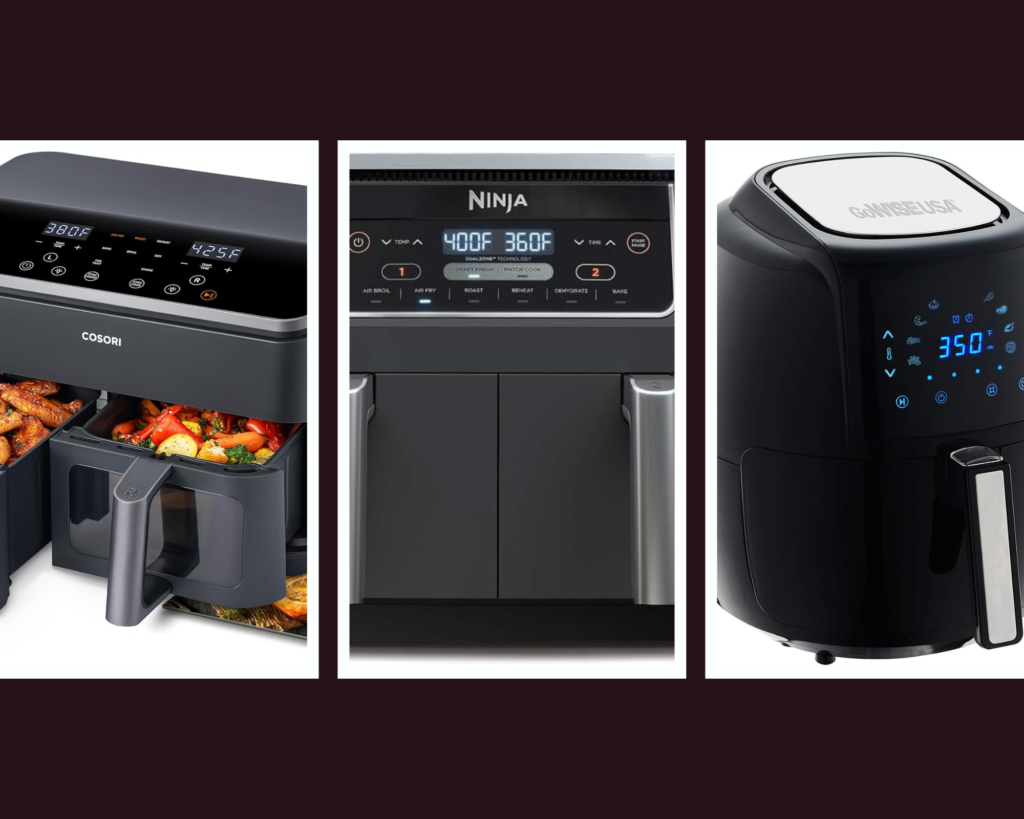
Hey there, fellow foodies and health enthusiasts! Gary here, and boy, do I have a treat for you today. We’re diving deep into the world of air fryers, focusing on two hot topics that’ll make your taste buds dance and your heart happy. First up, we’re exploring the best non-toxic air fryers and air frying tips for all you health-conscious consumers out there.
Spoiler alert: the top non-toxic air fryers are made with stainless steel or ceramic-coated baskets, avoid non-stick PTFE coatings, and use BPA-free plastic components. Some of the best options include the Ninja Foodi, Cosori Pro LE Air Fryer, and GoWISE USA 8-in-1 Digital Air Fryer.
But wait, there’s more! We’re also tackling the age-old question of how to convert your favorite oven recipes for air fryer use. The golden rule? Reduce the temperature by about 25°F (14°C) and cut the cooking time by about 20%. But don’t worry, I’ve got a detailed chart coming up that’ll make you an air frying conversion pro in no time.
So, grab your apron and let’s get cooking with this ultimate guide to healthy air frying!
Table of Contents:
- The Health-Conscious Consumer’s Guide to Non-Toxic Air Fryers
- Mastering the Art of Air Fryer Conversion
- Bonus: Healthy Air Fryer Recipes to Get You Started
- Conclusion
Now, let’s dive in and get crispy!
1. The Health-Conscious Consumer’s Guide to Non-Toxic Air Fryers
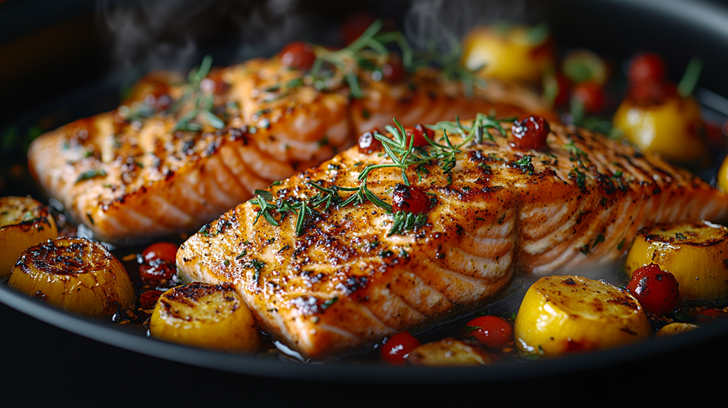
1.1 Why Non-Toxic Matters: The Lowdown on Air Fryer Materials
Alright, folks, let’s talk about why we’re even discussing “non-toxic” air fryers. You see, not all air fryers are created equal, especially when it comes to the materials they’re made from. Some air fryers use non-stick coatings that contain potentially harmful chemicals like PTFE (polytetrafluoroethylene), better known as Teflon. While these coatings make cleaning a breeze, they can release toxic fumes when heated to high temperatures.
Now, I’m not here to scare you. The FDA has stated that properly used Teflon-coated cookware is safe. But if you’re like me and prefer to err on the side of caution, especially when it comes to your family’s health, you might want to consider non-toxic alternatives.
So, what makes an air fryer “non-toxic”? Generally, we’re looking at air fryers that use:
- Stainless steel baskets
- Ceramic-coated baskets
- BPA-free plastic components
- No PTFE or PFOA in any of the parts that come into contact with food
These materials are considered safer because they don’t release potentially harmful chemicals when heated, even at the high temperatures air fryers can reach.
1.2 Top 5 Non-Toxic Air Fryers: Reviews and Comparisons
Now that we know what to look for, let’s check out some of the best non-toxic air fryers on the market. I’ve spent countless hours researching, testing, and yes, eating (it’s a tough job, but someone’s got to do it) to bring you this list.
- Ninja Foodi 8-Quart 6-in-1 DualZone Air Fryer

- Pros: Stainless steel basket, two independent cooking zones, versatile functions
- Cons: Large footprint, higher price point
- Perfect for: Large families or those who love to meal prep
2. Cosori Pro LE Air Fryer
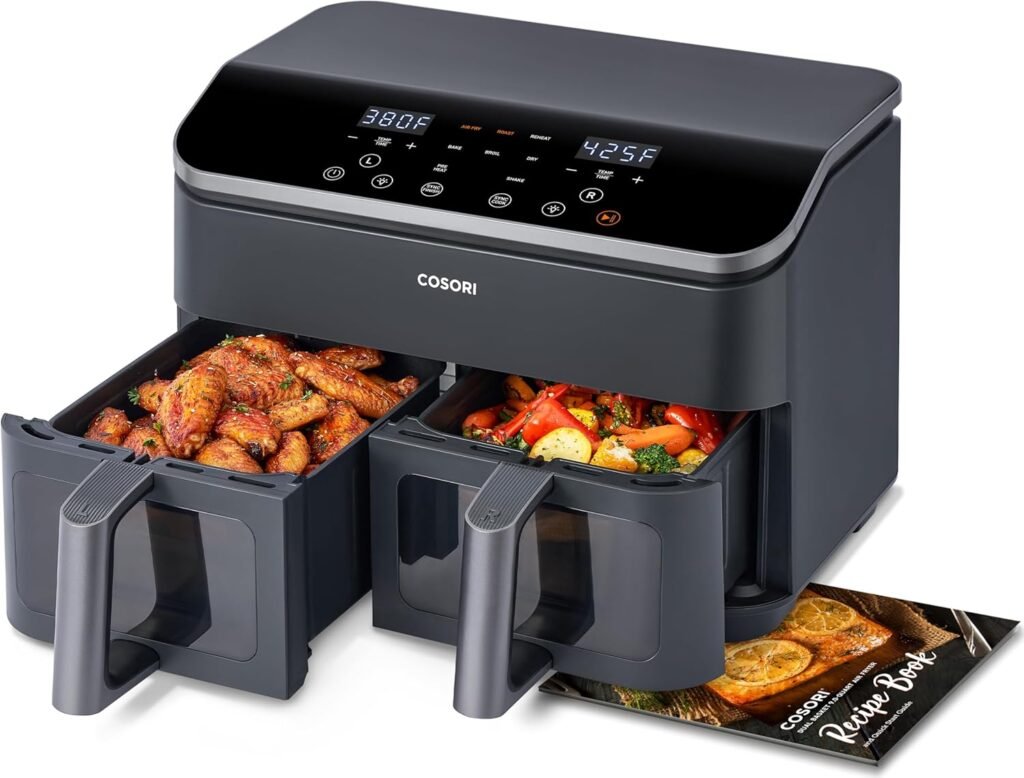
- Pros: Ceramic-coated basket, compact design, affordable
- Cons: Smaller capacity than some competitors
- Perfect for: Small households or those new to air frying
3. GoWISE USA 8-in-1 Digital Air Fryer
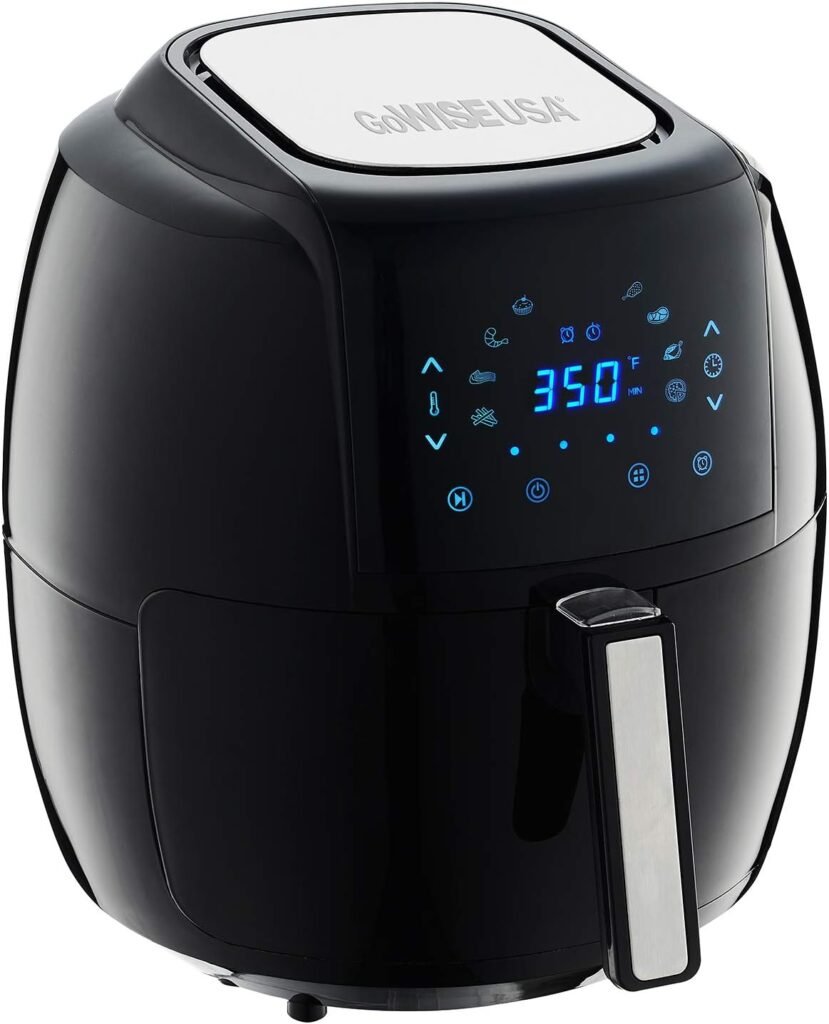
- Pros: Ceramic-coated basket, versatile presets, budget-friendly
- Cons: Can be noisy during operation
- Perfect for: Budget-conscious consumers who don’t want to sacrifice features
4. Instant Vortex Plus Air Fryer Oven
- Pros: Stainless steel drip pan and cooking trays, large capacity, multi-functional
- Cons: Takes up significant counter space
- Perfect for: Those who want an air fryer that can replace multiple appliances
5. Phillips Premium Airfryer XXL
- Pros: Removable stainless steel mesh cooking basket, powerful performance, large capacity
- Cons: Premium price point
- Perfect for: Those willing to invest in a top-of-the-line appliance
Each of these air fryers has its strengths, and the best choice for you will depend on your specific needs, kitchen space, and budget. But rest assured, all of these options prioritize your health with their non-toxic materials.
1.3 What to Look for When Choosing a Non-Toxic Air Fryer
- Material of the basket or cooking surface: Stainless steel and ceramic-coated surfaces are your champions here, folks. Stainless steel is durable, doesn’t leach chemicals, and can withstand high temperatures without breaking a sweat. Ceramic coatings, when done right, offer excellent non-stick properties without the potential risks associated with Teflon.
But here’s the kicker: not all ceramic coatings are created equal. Look for ones that specifically state they’re free from PTFE and PFOA. And remember, even with ceramic, avoid using metal utensils to prevent scratching.
- BPA-free certification: BPA (Bisphenol A) is like that party guest who overstays their welcome – nobody wants it around, especially in their food. While the basket might be stainless steel or ceramic, other parts of the air fryer could contain plastic. Make sure these are certified BPA-free.
But don’t stop at BPA. Look for air fryers that are also free from other concerning chemicals like phthalates and PVC. The fewer mystery chemicals in your cooking process, the better!
- Capacity: Size matters, especially when it comes to air fryers. Too small, and you’ll be cooking in frustrating batches. Too large, and you’re wasting energy and counter space.
Think about your typical meals. Cooking for one or two? A 2-4 quart model might suffice. Family of four or frequent entertainer? You might want to look at 5-7 quart models. Remember, it’s better to have a little extra space than not enough.
- Versatility: Some air fryers are one-trick ponies, while others are the Swiss Army knives of the kitchen. Consider models that offer multiple functions like baking, roasting, and dehydrating.
But here’s a pro tip: don’t be swayed by a long list of functions you’ll never use. Be honest about your cooking habits. If you’re mainly after crispy fries and chicken wings, a simpler model might be all you need.
- Ease of cleaning: Let’s face it, if it’s a pain to clean, you’re less likely to use it. Look for models with dishwasher-safe parts. Removable, non-stick baskets are a godsend.
But don’t just take the manufacturer’s word for it. Check user reviews to see how easy it really is to clean. Some “dishwasher safe” parts might still require scrubbing to get truly clean.
- Energy efficiency: In today’s world, being energy-efficient isn’t just good for your wallet – it’s good for the planet. Look for Energy Star certified models if available.
But energy efficiency isn’t just about the rating. Consider factors like preheating time and cooking speed. An air fryer that cooks faster ultimately uses less energy.
- Warranty and customer service: A good warranty is like a safety net for your purchase. Look for at least a 1-year warranty, but 2-3 years is even better.
But the warranty is only as good as the customer service backing it. Do some digging on the company’s reputation for honoring warranties and providing support. A quick online search can reveal a lot about real customer experiences.
Additional features to consider:
- Digital vs. manual controls: Digital can offer more precise temperature control, but manual can be simpler to use.
- Noise level: Some air fryers can be quite loud. If noise is a concern, look for models advertised as quiet or check user reviews.
- Preset programs: These can be handy for common foods, but make sure they align with what you actually cook.
Remember, the most important thing is to choose an air fryer that you’ll actually use. All the health benefits in the world won’t matter if your air fryer ends up collecting dust in a cabinet! Consider your cooking habits, kitchen space, and budget to find the perfect match for you.
And hey, don’t be afraid to test drive before you buy if possible. Some stores offer demonstrations, or you might have a friend with an air fryer who’d let you try it out. Nothing beats hands-on experience when making a decision like this.
1.4 Maintenance Tips for Your Non-Toxic Air Fryer
Listen up, air fryer aficionados! We’re about to dive into the world of air fryer maintenance – and trust me, it’s more crucial than you might think. Your trusty air fryer works hard to deliver those crispy, guilt-free treats you love, and without proper care, all that wear and tear can lead to reduced performance or even early retirement for your favorite kitchen gadget.
But fear not! With a few simple maintenance tips, you can keep your air fryer running like new, ensuring every meal is as delicious and healthy as the day you unboxed it. From cleaning tricks to storage smarts, these easy-to-follow tips will extend your air fryer’s life, improve its efficiency, and keep those tasty, low-fat meals coming. Ready to become an air fryer maintenance pro? Let’s get started!
1. Clean after each use: This isn’t just about being tidy, folks – it’s about preserving your air fryer’s performance and longevity. Food particles left behind can burn in the next use, affecting the taste of your food and potentially causing smoke.
- Let the air fryer cool completely before cleaning.
- Remove the basket and any removable parts.
- Soak these in warm, soapy water for about 10 minutes to loosen any stuck-on food.
- For stubborn residue, create a paste with baking soda and water. Apply it, let it sit for a few minutes, then wipe clean.
- Don’t forget to wipe down the interior and exterior of the main unit with a damp cloth.
Pro tip: Line the bottom of your air fryer with foil or parchment paper to catch drips and make cleanup even easier.
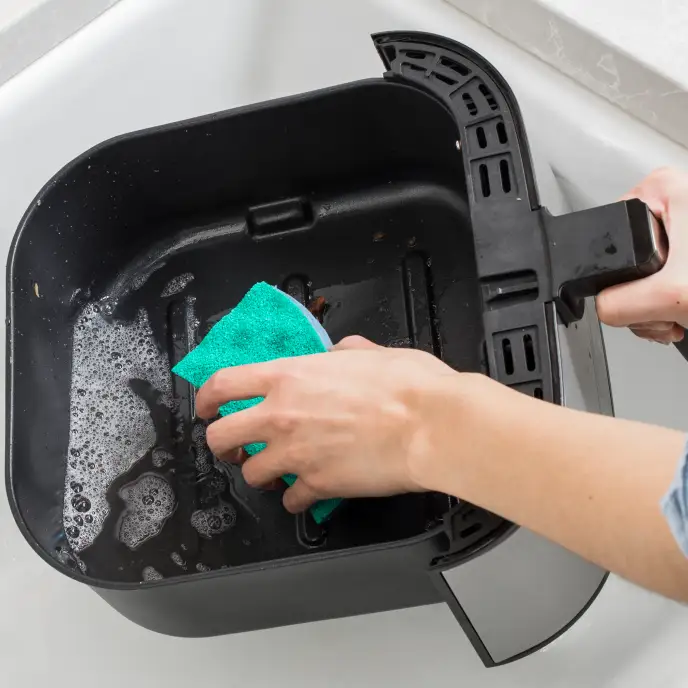
2. Avoid abrasive cleaners: Harsh scrubbers and strong chemicals are a big no-no. They can scratch or damage the non-toxic coating, which not only affects performance but could also lead to the coating flaking off into your food.
- Use soft sponges, microfiber cloths, or soft-bristled brushes.
- Stick to mild dish soap or create a cleaning solution with equal parts water and white vinegar.
- For tough grease, let the parts soak in hot, soapy water before gently wiping clean.
Remember: If you need to scrub, use gentle, circular motions rather than aggressive back-and-forth scrubbing.
3. Dry thoroughly: Water is the enemy of many kitchen appliances, and your air fryer is no exception. Proper drying prevents rust, mold, and bacterial growth.
- After washing, shake off excess water.
- Use a clean, lint-free towel to dry all parts thoroughly.
- For hard-to-reach areas, use a clean, dry brush or cotton swabs.
- Consider air-drying the basket and removable parts for an hour or so before reassembling.
Pro tip: Run the air fryer empty for 2-3 minutes after cleaning to ensure all parts are completely dry.
4. Check for wear and tear: Regular inspections can catch potential issues before they become problems. This is especially important for maintaining the non-toxic integrity of your air fryer.
- Before each use, give your air fryer a quick once-over.
- Look for any signs of peeling or chipping in the basket or cooking surfaces.
- Check that all parts fit together snugly with no loose components.
- Inspect the power cord for any fraying or damage.
If you notice any issues, it’s better to replace the part (or the entire unit if necessary) than risk using a damaged appliance.
5. Store properly: Proper storage is key to maintaining your air fryer’s condition and preventing unnecessary wear and tear.
- Ensure the air fryer is completely cool and dry before storing.
- Store in a clean, dry place away from heat sources and water.
- If possible, store with the basket slightly open to allow air circulation and prevent odors.
- Consider using a dust cover if you’re storing it for an extended period.
- Avoid stacking heavy items on top of your air fryer.
Bonus tip: Use your air fryer regularly! Ironically, appliances that sit unused for long periods often deteriorate faster than those used regularly and maintained properly.
6. Deep clean monthly: In addition to cleaning after each use, give your air fryer a deep clean once a month.
- Remove and clean the heating element (consult your manual for safe cleaning methods).
- Clean the fan (if accessible) with a soft brush to remove any dust or debris.
- Check and clean any vents or air intakes.
7. Deodorize as needed: If your air fryer starts to develop odors.
- Cut a lemon in half and rub it on the interior surfaces.
- Or, run the air fryer with a mixture of water and lemon juice for a few minutes.
Remember, a well-maintained air fryer isn’t just about cleanliness – it’s about safety, efficiency, and ensuring your food always tastes its best. With these expanded tips, your air fryer will be serving up crispy, healthy delights for years to come!
2. Mastering the Art of Air Fryer Conversion

2.1 The Science Behind Air Fryer Cooking
Before we dive into converting recipes, let’s geek out for a moment on the science of air frying. Air fryers work by circulating hot air around the food at high speed. This creates a crispy exterior similar to deep-frying, but with much less oil.
The Maillard reaction, responsible for that delicious brown crust on foods, happens more quickly in an air fryer due to the intense heat and air circulation. This is why air fryers can cook food faster than conventional ovens while still achieving that coveted crispy texture.
Understanding this science helps us make smart decisions when converting recipes. We know we need to adjust for the faster cooking time and the more intense heat distribution.
2.2 General Rules for Converting Oven Recipes to Air Fryer
Alright, let’s get to the meat of the matter (pun intended). Here are some general rules to follow when converting your favorite oven recipes for air fryer use:
- Temperature: Reduce the oven temperature by about 25°F (14°C) for air frying.
- Time: Start by reducing the cooking time by about 20%, then check and adjust as needed.
- Size matters: Cut large items into smaller pieces for more even cooking.
- Don’t overcrowd: Arrange food in a single layer for best results.
- Shake it up: Shake the basket or flip food halfway through cooking for even browning.
- Use oil sparingly: A light spray or brush of oil is usually sufficient.
- Adjust as you go: Every air fryer is different, so be prepared to experiment a bit.
2.3 Comprehensive Air Fryer Conversion Chart
Now, here’s what you’ve all been waiting for – the ultimate air fryer conversion chart! Remember, these are guidelines. Always check your food for doneness and adjust as needed.
| Food Item | Oven Temp (°F) | Oven Time (min) | Air Fryer Temp (°F) | Air Fryer Time (min) |
|---|---|---|---|---|
| Chicken Breast | 375 | 25-30 | 350 | 20-25 |
| Salmon Fillet | 400 | 12-15 | 375 | 10-12 |
| French Fries | 425 | 30-35 | 400 | 15-20 |
| Roasted Vegetables | 400 | 20-25 | 375 | 15-20 |
| Pork Chops | 375 | 25-30 | 350 | 20-25 |
| Mozzarella Sticks | 450 | 8-10 | 400 | 6-8 |
| Chicken Wings | 400 | 45-50 | 375 | 25-30 |
| Breaded Fish | 425 | 15-20 | 400 | 12-15 |
| Pizza | 450 | 10-15 | 400 | 8-10 |
| Cookies | 350 | 10-12 | 325 | 8-10 |
Remember, these times are for average-sized portions. Adjust accordingly for larger or smaller pieces.
2.4 Tips for Perfect Air Fryer Results Every Time
- Preheat your air fryer: Just like an oven, preheating ensures even cooking from the start.
- Use a meat thermometer: This is especially important when cooking meats to ensure they’re fully cooked.
- Don’t rely on browning alone: Air fryers can brown food quickly, but that doesn’t always mean it’s cooked through.
- Experiment with different oils: Some oils work better at high temperatures than others.
- Line the basket: For messy foods, a parchment paper liner can make cleanup a breeze.
- Resist the urge to peek too often: Opening the air fryer lets out heat and can affect cooking times.
- Let it rest: Just like with oven cooking, letting meat rest after air frying helps redistribute the juices.
3. Bonus: Healthy Air Fryer Recipes to Get You Started

Now that you’re armed with knowledge about non-toxic air fryers and how to convert recipes, let’s put it all into practice with some healthy air fryer recipes!
Air Fryer Cauliflower Wings
Ingredients:
- 1 head cauliflower, cut into florets
- 1/2 cup whole wheat flour
- 1/2 cup water
- 1 tsp garlic powder
- 1 tsp paprika
- Salt and pepper to taste
- 1/4 cup hot sauce (for buffalo style)
Instructions:
- Mix flour, water, and spices in a bowl.
- Dip cauliflower florets in the batter.
- Air fry at 375°F for 15 minutes, shaking halfway through.
- If desired, toss in hot sauce and air fry for an additional 5 minutes.
Air Fryer Salmon with Lemon and Dill
Ingredients:
- 2 salmon fillets
- 1 tbsp olive oil
- 1 lemon, sliced
- Fresh dill
- Salt and pepper to taste
Instructions:
- Brush salmon with olive oil and season with salt and pepper.
- Place lemon slices and dill on top.
- Air fry at 375°F for 10-12 minutes, depending on thickness.
Conclusion
There you have it, folks! Your comprehensive guide to non-toxic air fryers and recipe conversion. With these tips and tricks up your sleeve, you’re well on your way to becoming an air frying maestro. Remember, the key to great air frying is experimentation. Don’t be afraid to try new things and adjust recipes to your liking.
Air frying is more than just a trend – it’s a healthier way to enjoy your favorite foods without sacrificing taste or texture. And with a non-toxic air fryer, you can have peace of mind knowing you’re making the best choice for your health and the environment.
So, what are you waiting for? Dust off that air fryer (or invest in a shiny new non-toxic one) and start cooking! Your taste buds – and your waistline – will thank you. Until next time, this is Gary, reminding you that good food and good health go hand in hand. Happy air frying!





2 Comments